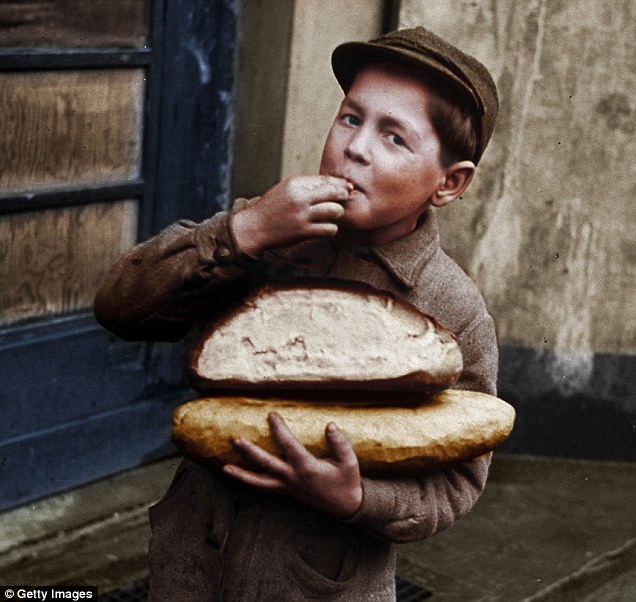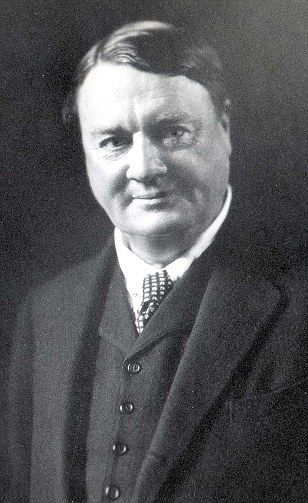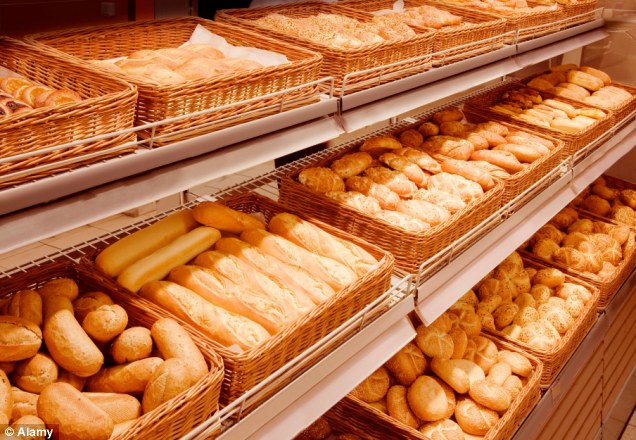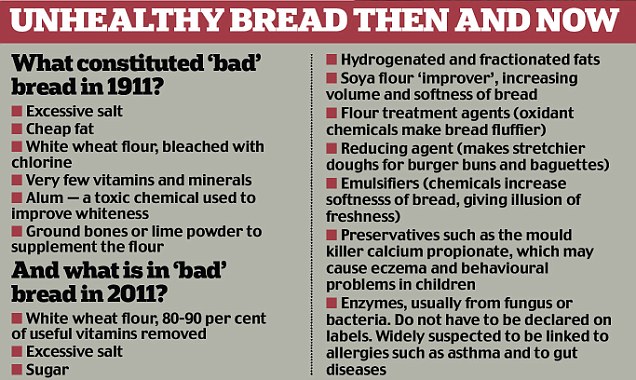In 2011, this story should be no more than newspaper history. Shockingly, though, the fight for better bread as being key to better health continues to this day.
Back then, standards of nutrition in Britain were of major concern to the government. During the 19th century, as the industrial revolution pushed millions of Britons from the countryside into the cities, the nation's diet got rapidly worse - and many health problems seemed linked to that.

By 1902, the Army had been forced to reduce the minimum height requirement for recruits by six inches, to just five foot. And still it rejected 40 per cent on grounds of poor health and bad teeth.
The low quality of bread, which made up 40 per cent of the diet of the poor in Britain in 1911, was widely blamed: modern nutritional science has shown that bread was indeed a crucial villain.
All levels of society then insisted on eating white, as brown or wholemeal bread was a sign of poverty. But as we now know, refined white flour contains very little of the natural minerals and vitamins that bread made using the whole wheatgerm does.
In particular, vitamin B deficiency causes a whole range of illnesses that the Victorians called 'wasting diseases', such as anaemia. Worse, the white flour our ancestors used was usually contaminated, often with the toxic chemical alum (made with human urine), which made bad quality flour look whiter.

By 1911, Lord Northcliffe, the founder and owner of the Daily Mail, had turned it into the world's best-selling newspaper, and in January of that year ran a story on the huge popularity of a campaign for better bread begun by the MP Sir Oswald Mosley.
In an interview, the MP (who was later to become notorious as leader of a British fascist party) told the Mail that bad bread was to blame for 'degeneracy' and 'the decline in the national physique'.
This struck a chord with Lord Northcliffe, who loved to campaign on grand, popular issues. Convinced that bad bread was the key to poor nutrition and bad health, he put the Mail's famous team of war correspondents and crime writers to work on the battle against white bread.
'The delicious old farmhouse and cottage bread made the bone and sinew of Englishmen and the beauty of English women famous before the craze for white starch bread began,' wrote one Mail writer.
The paper called for a 'Standard Bread' to be developed, made from unadulterated flour and at least 80 per cent of the germ of the wheat. A gold cup and prizes worth a total of £600 (now £55,000) for the best standard loaves that readers could make were offered, and these were shown at exhibitions nationwide.
Lord Northcliffe told reporters he wanted a story about bread in the paper every day for a year - or until the battle was won. And so there were interviews with doctors who said wholemeal bread reduced the craving for alcoholic stimulants, and with ministers who believed wholemeal bread was conducive to a more moral life.
There was a heart-rending account of a little girl, a flour-miller's daughter, who had always been ailing, but since switching to 'standard bread' now had 'the bloom of health' in her cheeks.
However, most millers opposed the idea of standard bread as being too costly and an unscientific fad, while in high society Northcliffe was widely mocked. Some people said he'd only started the campaign in order to win an argument about the power of his papers.
But the genuine science and the public were on Northcliffe's side, and the battle over bread soon turned the Mail's way.

A few weeks after the campaign started, eight eminent doctors, including Sir Alfred Fripp, the King's surgeon, sent a 'Manifesto' to the Daily Mail, calling for the government to bring in legislation on a standard quality of bread, along the lines Northcliffe and Mosley had suggested.
The doctors said that the introduction of wholemeal bread was a 'national necessity' - especially for the poor, since white bread, with its 'inferior nourishing qualities', was about the only thing the poorest children got to eat.
That tipped the balance. The King, George V, asked for 'standard bread' to be delivered to the royal household. Lists of bakers who would offer standard bread were published, and the idea of wholesome bread and home baking took off.
By the end of October 1911, the paper felt able to announce 'The Triumph Of Standard Bread - A Change in the Food Of A Nation'.
'Today, Standard Bread is firmly established in the homes of hundreds of thousands of families ... demand is increasing. In many places, the cream-coloured loaf has completely ousted the pasty-white usurper ...' ran the article.
Even Northcliffe's enemies were forced to admit he had done the nation's health some good.
Though Parliament debated Standard Bread, the government did not act in 1911. During World War II, however, white bread was banned entirely. As a result, the nation was said to be healthier in 1947, after eight years of brown bread and rationing, than it was in 1939.
So, what has all this got to do with today's bread?
White bread was made legal again after the end of the war, and supermarket shelves are now filled with dozens of different types of bread - white, brown and black.
Though rickets is a distant memory, the Real Bread Campaign, a non-profit pressure group, claims that bread has actually got worse since 1911 in terms of secret adulterants - enzymes that do not have to be declared on labels - still being smuggled into it.
Today, despite the modern fashion for healthy eating, 'nutritionally empty' white bread accounts for more than 50 per cent of what we buy.

Meanwhile, there is growing belief among medical researchers that modern industrial baking methods may be behind today's extraordinary rise in digestive illness such as gluten intolerance and coeliac disease.
'People suffering from coeliac disease or from joint pain find that they do not do so if they eat traditional sour-dough bread,' says author and baker Andrew Whitley. 'The bread on offer in the shops seems to be making people ill!' he writes in his influential book, Bread Matters.
Whitley sells a sourdough rye bread that ferments with the natural yeasts in the flour over 24 hours. He believes that customers who eat his bread find that their digestive problems disappear.
Bread historians bemoan the day in 1961 when the Chorleywood Baking Process (CBP) was introduced.
By juggling chemicals, flour types and adding three times as much yeast as had been used by bakers before, and then mixing at high speed, the scientists at Chorleywood Food Research Institute brought out a bread that was 40 per cent softer than previous loaves, and lasted twice as long.
This was the beginning of modern bread - 'plastic bread' to its detractors. Eighty per cent of all bread is still made the Chorleywood way.
The most significant charge against CBP is that by increasing the yeast element, it may also have given birth to modern bread-related digestive illness, by introducing more yeasts to the gut flora that help us break down food.
More worrying are the enzymes that are used to aid the process - and give the idea of lightness and freshness. These don't have to be declared on ingredients lists because they are 'processing aids'.
One of the most common, amylase, is known to cause asthma, a common disease among bakers. Others have been linked to illnesses of the gut, such as coeliac disease.
As author Joanna Blythman, a critic of the food industry, says in her book Shopped: 'Enzymes are our supermarkets' way of giving us "fresh" bread that lasts a week ... until it suddenly goes green.'
Lord Northcliffe and the Daily Mail of 1911 would not approve, says Real Bread campaigner Chris Young.
'Given his belief that the people of Britain deserve the most wholesome bread possible, I think Lord Northcliffe would turn in his grave if he could see the state of factory loaves today.
'Once, the law was designed to protect us from manufacturers adulterating our daily loaves.

'Now, it enshrines their right to throw in a whole cocktail of chemicals - and at the same time denies the people of Britain the right to know whether or not a handful of so-called processing aids has been snuck in, too.
'We want the Government to give bread the same sort of protection as butter, so anyone wanting to throw in additives would have to come up with another name for it.
'We believe it should be illegal to call that stuff bread.'




Reader Comments
to our Newsletter